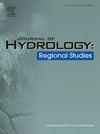Study on the nonlinear transition relationship between water resources consumption and economic development in Heilongjiang province based on system dynamics
IF 4.7
2区 地球科学
Q1 WATER RESOURCES
引用次数: 0
Abstract
Study region
Heilongjiang Province, north-eastern region of China.
Study focus
Water resources are important resources for steady economic and social progress, and the coordination between water resources consumption and economic development is the prerequisite for ensuring sustainable regional development. This study aims to promote the coordination of water resources consumption and economic development in Heilongjiang Province. In this study, system dynamics was used as a technical tool to simulate the water consumption and economic benefits of Heilongjiang Province from 2000 to 2050. The nonlinear trend of water resources consumption and economic development in Heilongjiang Province was explored by using the Sequential T-Test analysis of regime shifts (STARS) and the threshold generalized additive models (TGAM) for the first time.
New hydrological insights for the region
The results indicated the following: (1) No nonlinear changes in agricultural water footprint (WFA) were detected in Heilongjiang Province. Both the industrial water footprint (WFI) and the domestic water footprint (WFD) showed one nonlinear change in 2018. Two nonlinear changes in ecological water footprint (WFE) in 2021 and 2033. (2) The WEF in Heilongjiang Province fluctuated, reaching a peak of 8.32 × 107 hm2 in 2007 and a low of 4.31 × 107 hm2 in 2019. The water ecological footprint (WEF) per 104 yuan GDP decreased from 2.39 hm2/104 yuan to 0.29 hm2/104 yuan. (3) Thresholds in the total WF and WEF with GDP were detected in 2010 and 2017. (4) The decoupling of the WF and WEF from economic development in Heilongjiang Province was mostly in intermediate optimal state, but with higher water consumption. The findings provide valuable insights for accelerating the green transformation of Heilongjiang Province and fostering the economy's and water resources' outstanding development.
求助全文
约1分钟内获得全文
求助全文
来源期刊

Journal of Hydrology-Regional Studies
Earth and Planetary Sciences-Earth and Planetary Sciences (miscellaneous)
CiteScore
6.70
自引率
8.50%
发文量
284
审稿时长
60 days
期刊介绍:
Journal of Hydrology: Regional Studies publishes original research papers enhancing the science of hydrology and aiming at region-specific problems, past and future conditions, analysis, review and solutions. The journal particularly welcomes research papers that deliver new insights into region-specific hydrological processes and responses to changing conditions, as well as contributions that incorporate interdisciplinarity and translational science.
 求助内容:
求助内容: 应助结果提醒方式:
应助结果提醒方式:


